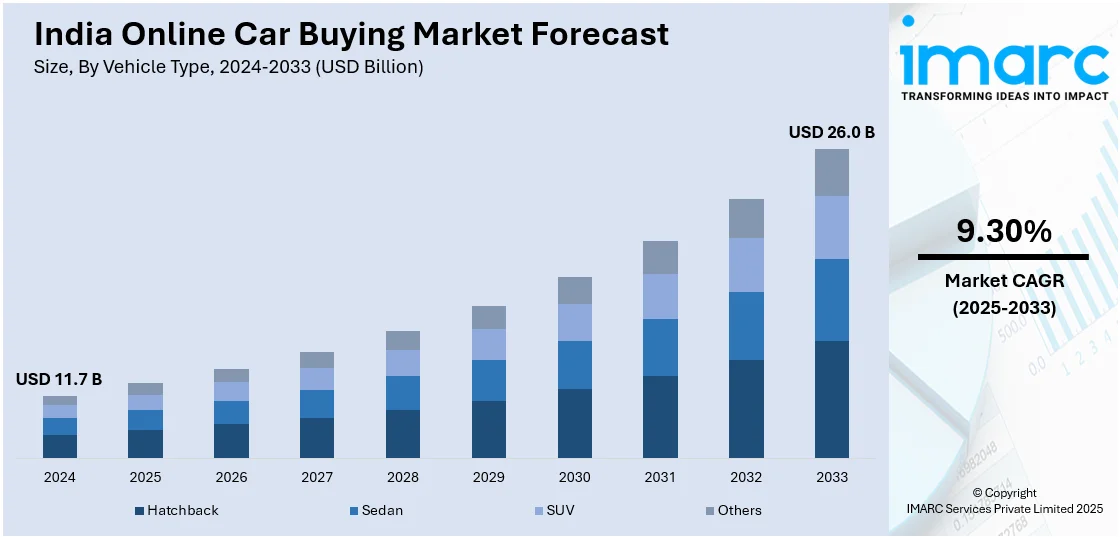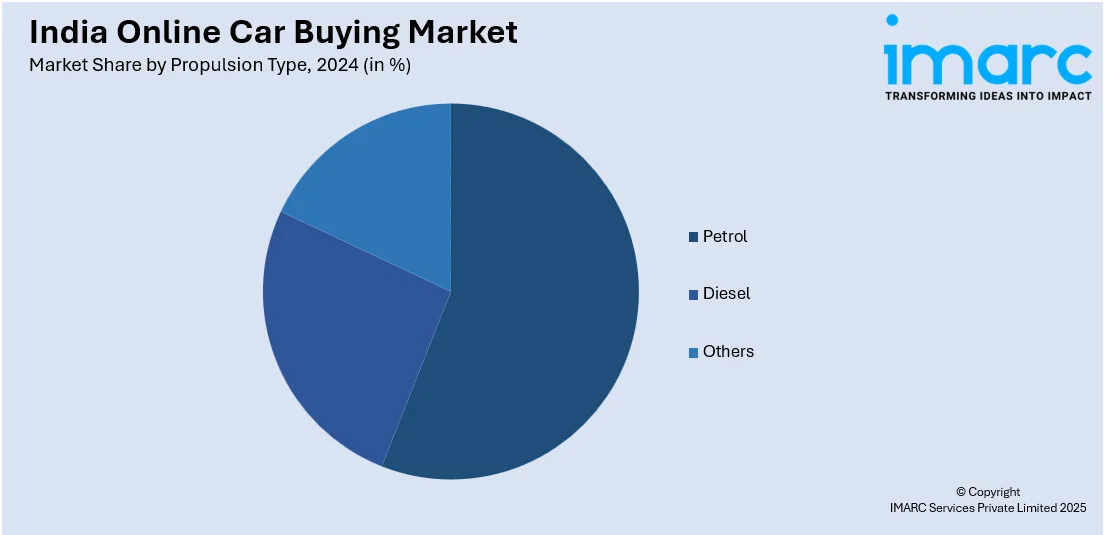
India Online Car Buying Market Size, Share, Trends and Forecast by Vehicle Type, Propulsion Type, Category, and Region, 2025-2033
India Online Car Buying Market Overview:
The India online car buying market size reached USD 11.7 Billion in 2024. Looking forward, IMARC Group expects the market to reach USD 26.0 Billion by 2033, exhibiting a growth rate (CAGR) of 9.30% during 2025-2033. The rising smartphone penetration, increasing internet access, growing preference for contactless transactions, expanding digital infrastructure, time-saving convenience, wider vehicle selection, transparent pricing, improved online financing options, rising trust in e-commerce platforms, and enhanced virtual tools, such as 360-degree views and AI chat support, are some of the major factors augmenting the India online car buying market share.
|
Report Attribute
|
Key Statistics
|
|---|---|
|
Base Year
|
2024 |
|
Forecast Years
|
2025-2033
|
|
Historical Years
|
2019-2024
|
| Market Size in 2024 | USD 11.7 Billion |
| Market Forecast in 2033 | USD 26.0 Billion |
| Market Growth Rate 2025-2033 | 9.30% |
India Online Car Buying Market Trends:
Rise of Omnichannel Car Retailing
Online car buying in India is moving toward an omnichannel model, blending digital convenience with physical touchpoints. According to an industry report, approximately 45% of customers prefer an omnichannel strategy in retail. Consumers are increasingly beginning their car purchases online by comparing models, calculating EMIs, and scheduling test drives. However, they continue to require offline support for final steps such as vehicle inspection, documentation, and delivery. Companies are adapting by integrating doorstep test drives, hybrid documentation support, and flexible return policies, which are positively impacting the India online car buying market outlook. This trend is reshaping the role of dealerships from sales-driven outlets to fulfilment and service centers. Players offering seamless transitions between online and offline stages are gaining an edge. Consumers in Tier 1 and Tier 2 cities are especially drawn to platforms offering local pickup, service aggregation, and warranty-backed options. As car ownership in India grows more personalized, a multi-touchpoint approach helps reduce friction. In addition to this, Financing options are increasingly integrated with omnichannel experiences, combining digital applications with in-person document verification. This approach enhances customer convenience, improves accessibility, and ensures a seamless transition between online and offline interactions. The omnichannel trend is fostering greater trust, accelerating decision-making processes, expanding financial services into semi-urban regions, and enabling more inclusive access to credit and banking solutions.

To get more information on this market, Request Sample
Increased Penetration of Used Car Platforms
India’s used car market is expanding rapidly due to affordability, higher vehicle replacement cycles, and improved online platforms. According to industry reports, the used-car market in India is expected to reach one Crore annual sales by 2030. Additionally, startups and incumbents are professionalizing the pre-owned segment, offering vehicle certification, return policies, and home delivery. Trust-enhancing features, such as comprehensive 140-point inspection reports, fixed-price models, and warranty-backed purchases, are reshaping buyer perceptions, particularly among first-time owners. Moreover, digital platforms are also improving resale experiences through artificial intelligence (AI) powered pricing engines, RC transfer support, and instant payment models. Besides this, organized online platforms address trust and convenience. Therefore, more users are skipping traditional, unorganized dealers. The market is gaining momentum not only in metropolitan areas but also in smaller cities, where the demand for reliable and cost-effective vehicles is strong. Furthermore, the increasing adoption of smartphones and the availability of regional language interfaces are enabling platforms to reach and engage non-English-speaking segments more effectively. The evolving consumer mindset, wherein buyers perceive used vehicles as value-driven purchases rather than compromises, is accelerating the India online car buying market growth.
India Online Car Buying Market Segmentation:
IMARC Group provides an analysis of the key trends in each segment of the market, along with forecasts at the country level for 2025-2033. Our report has categorized the market based on vehicle type, propulsion type, and category.
Vehicle Type Insights:
- Hatchback
- Sedan
- SUV
- Others
The report has provided a detailed breakup and analysis of the market based on the vehicle type. This includes hatchback, sedan, SUV, and others.
Propulsion Type Insights:

- Petrol
- Diesel
- Others
A detailed breakup and analysis of the market based on the propulsion type have also been provided in the report. This includes petrol, diesel, and others.
Category Insights:
- Pre-Owned Vehicle
- New Vehicle
The report has provided a detailed breakup and analysis of the market based on the category. This includes pre-owned vehicle and new vehicle.
Regional Insights:
- North India
- South India
- East India
- West India
The report has also provided a comprehensive analysis of all the major regional markets, which include North India, South India, East India, and West India.
Competitive Landscape:
The market research report has also provided a comprehensive analysis of the competitive landscape. Competitive analysis such as market structure, key player positioning, top winning strategies, competitive dashboard, and company evaluation quadrant has been covered in the report. Also, detailed profiles of all major companies have been provided.
India Online Car Buying Market News:
- On March 10, 2025, CARS24 launched its 'New Cars' platform in India, aiming to streamline the car-buying process digitally by offering real on-road pricing, AI-powered video walkthroughs, and home test drives. This initiative addresses the traditionally fragmented and complex nature of purchasing new vehicles, providing a unified and transparent experience for consumers. By integrating essential information and services into a single platform, CARS24 seeks to enhance convenience and efficiency for car buyers nationwide.
India Online Car Buying Market Report Coverage:
| Report Features | Details |
|---|---|
| Base Year of the Analysis | 2024 |
| Historical Period | 2019-2024 |
| Forecast Period | 2025-2033 |
| Units | Billion USD |
| Scope of the Report |
Exploration of Historical Trends and Market Outlook, Industry Catalysts and Challenges, Segment-Wise Historical and Future Market Assessment:
|
| Vehicle Types Covered | Hatchback, Sedan, SUV, Others |
| Propulsion Types Covered | Petrol, Diesel, Others |
| Categories Covered | Pre-Owned Vehicle, New Vehicle |
| Regions Covered | North India, South India, East India, West India |
| Customization Scope | 10% Free Customization |
| Post-Sale Analyst Support | 10-12 Weeks |
| Delivery Format | PDF and Excel through Email (We can also provide the editable version of the report in PPT/Word format on special request) |
Key Benefits for Stakeholders:
- IMARC’s industry report offers a comprehensive quantitative analysis of various market segments, historical and current market trends, market forecasts, and dynamics of the India online car buying market from 2019-2033.
- The research report provides the latest information on the market drivers, challenges, and opportunities in the India online car buying market.
- Porter's five forces analysis assist stakeholders in assessing the impact of new entrants, competitive rivalry, supplier power, buyer power, and the threat of substitution. It helps stakeholders to analyze the level of competition within the India online car buying industry and its attractiveness.
- Competitive landscape allows stakeholders to understand their competitive environment and provides an insight into the current positions of key players in the market.
Key Questions Answered in This Report
The online car buying market in the India was valued at USD 11.7 Billion in 2024.
The India online car buying market is projected to exhibit a CAGR of 9.30% during 2025-2033, reaching a value of USD 26.0 Billion by 2033.
The India online car buying market is growing due to increased internet penetration, a shift towards digital shopping, and the convenience of comparing prices and models. Individuals are attracted by home delivery options, flexible financing, and transparent pricing. The rise of e-commerce platforms and better client experience are also major contributors to this trend.
Need more help?
- Speak to our experienced analysts for insights on the current market scenarios.
- Include additional segments and countries to customize the report as per your requirement.
- Gain an unparalleled competitive advantage in your domain by understanding how to utilize the report and positively impacting your operations and revenue.
- For further assistance, please connect with our analysts.
 Request Customization
Request Customization
 Speak to an Analyst
Speak to an Analyst
 Request Brochure
Request Brochure
 Inquire Before Buying
Inquire Before Buying




.webp)




.webp)












